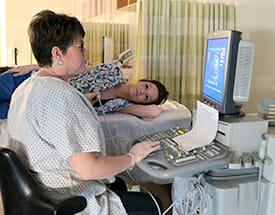Cardiac Sonography
Diagnostic medical sonography (DMS) is a multi-specialty occupation comprised of abdominal-extended sonography, adult cardiac sonography, breast sonography, musculoskeletal sonography, obstetrics and gynecology sonography, pediatric cardiac sonography, vascular sonography, and other emerging clinical areas or concentrations.
These concentrations all use comprehensive knowledge of ultrasound technology in their daily work. The trained technologist is an individual who provides patient care services applying ultrasound technology in the performance of diagnostic and/or therapeutic exams and procedures. As an occupational prerequisite the diagnostic medical sonographer must be educationally prepared and clinically competent. Demonstration and maintenance of competency through certification by a nationally recognized credentialing organization is the standard of practice in sonography. Maintenance of certification in all areas of practice is endorsed.
The diagnostic medical sonographer functions as a delegated agent of the physician and does not practice independently. Diagnostic medical sonographers are committed to enhanced patient care and continuous quality improvement that increases knowledge and technical competence. Diagnostic medical sonographers use independent, professional and ethical judgment, and critical thinking to safely perform diagnostic procedures.
The diagnostic medical sonographer generally performs the following:
- Obtains, reviews, and integrates pertinent patient history and supporting clinical data to facilitate optimum diagnostic results;
- Performs appropriate procedures and records anatomic, pathologic, and/or physiologic data for interpretation by a physician;
- Records, analyzes, and processes diagnostic data and other pertinent observations made during the procedure for presentation to the interpreting physician;
- Exercises discretion and judgment in the performance of sonographic and/or related diagnostic services;
- Demonstrates appropriate communication skills with patients and colleagues;
- Acts in a professional and ethical manner;
- Facilitates communication and education to elicit patient cooperation and understanding of expectations and responds to questions regarding the sonographic examination.
As a multi-specialty occupation, these Standards apply to the following learning concentrations:
- Abdominal Extended Sonography
- Adult Cardiac Sonography
- Breast Sonography
- Musculoskeletal Sonography
- Obstetrics and Gynecology Sonography
- Pediatric Cardiac Sonography
- Vascular Sonography

Jackson College Offers the following program options:
Cardiac Sonography at Jackson College
Get Started
An associate degree and certification is necessary to become a sonographer. Jackson College’s programs are accredited by the Commission on Accreditation of Allied Health Education Programs (CAAHEP). Cardiac sonography at JC is a second-admit program, which means students must submit an application after completing the prerequisite courses. Admission to the program is competitive and based on a point system. Students will participate in a clinical experience as part of the program. Upon successful completion, students are eligible to apply for certification exams through the American Registry for Diagnostic Medical Sonography.
Job Opportunities
Also called ultrasound technologists, most sonographers work in hospitals, while some work in physician’s offices or medical laboratories.
Career Outlook Quick Facts
| Title | Outlook |
|---|---|
| 2022 Median Pay | $78,210 per year, $37.60 per hour |
| Typical Entry-Level Education | Associate’s degree |
| Work Experience in a Related Occupation | None |
| On-the-job Training | None |
| Number of Jobs, 2022 | 142,800 |
| Job Outlook, 2022-32 | 10% (Much faster than average) |
| Employment Change, 2022-32 | 14,200 |
Source: U.S. Bureau of Labor Statistics Occupational Outlook Handbook
Professional Organizations
For career resources, visit the following professional organizations:

